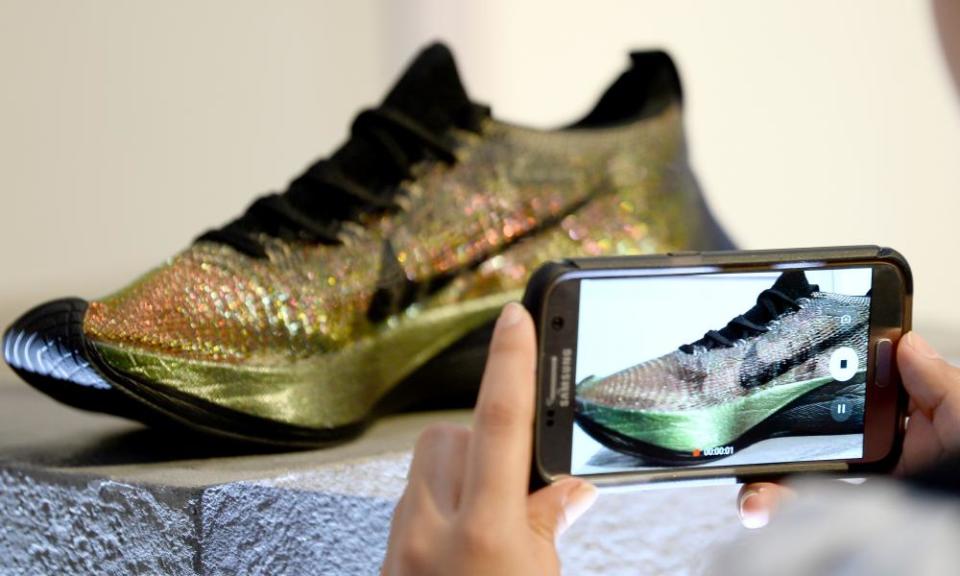Nike’s lightning shoes hint at power of technology to skew elite competition

Do you know the most remarkable thing about Nike’s £200 Vaporfly Elite trainers? They actually live up to the hype. When the shoe was launched last year, Nike insisted it improved running economy by an average of 4% – a claim so astounding that it caused many sports scientists’ eyebrows to rise in scepticism, loosely aping the company’s swoosh logo.
However last week, the New York Times, having analysed 495,000 marathon and half-marathon times since 2014 using data from Strava, reached a similar conclusion. Runners who wore Vaporflys, which have a controversial carbon-fibre plate in their soles, did indeed run 3-4% quicker on average than similar runners wearing other shoes, and around 1% faster than those using the next speediest shoe.
Your first instinct might be to rush out and buy a pair – especially as a separate study in the journal Sports Medicine on elite athletes estimated that the shoes could take six minutes off a three-hour marathoner’s time. Good luck with that. The shoes appear to be almost permanently sold out, and often go for double their retail price on eBay.
A more pressing task is to ask whether the shoes – and other forms of cutting-edge technology – go too far. Do they, in effect, turn what is supposed to be a level playing field in one that more resembles the slope of the Eiger?
A case can be made that the Vaporflys have already created at least one major sliding-doors moment in elite sport. Roger Pielke Jnr, the director of the sports governance centre at the University of Colorado Boulder, notes that in the 2016 US Olympic marathon trials, Kara Goucher finished in fourth – missing out on the plane to Rio by just one place. Yet the winner, Amy Cragg, along with the third-placed runner, Shalane Flanagan, were both wearing early prototypes of the Vaporflys, which he believes could have made all the difference to the result.
“It is highly likely that Goucher is the first known athlete to miss the Olympics due to shoe technology,” says Pielke. “The mean improvement of Nike Vaporfly for women and fastest runners is around 2%. Put Goucher into Vaporflys in the 2016 US marathon trials, and she gets a spot if they improve her performance by only 0.7%.”
The kicker? If Goucher had not left the Nike Oregon Project after raising concerns about its use of TUEs and thyroid medication, she may indeed have been wearing those shoes.
So where should we draw the line? On the one hand you cannot blame companies for striving to break new ground. They have profits to chase, consumers to satisfy, competitors breathing down their neck. We want these products, too. Only the most masochistic of runners attempts marathons in bare feet or old‑school trainers.
The International Association of Athletics Federations, the world governing body, also insists that Nike’s game-changing shoe meets all its requirements and “does not require any special inspection or approval”. Yet elite competition also requires a semblance of fairness. At some point the IAAF will have to rule on the permissible amount of energy return allowed from cushioning materials and whether carbon‑fibre devices in midsoles should be banned.
Such discussions stretch beyond track and field. In 2009, the sports governing body of swimming, Fina, banned the LZR Racer swimsuit because it was said to reduce skin friction drag by 24%. Yet in other sports the rules appear a little looser. Take British Cycling’s skinsuits, which they have used at Olympic Games since 2008 and are said to improve performance by up to 7%. That is a colossal advantage – yet the UCI has ruled they are legal.
Some inside the system concede that it would take other nations vast sums to replicate such technology. Elite competition is about winning, they point out, and if the rules permit the skinsuits what is the problem? Similar technology was also used to help Team GB win three skeleton medals in Pyeongchang – much to the delight of the nation.
Yet it is only natural to also feel a bit queasy about this, because it means that a cyclist from a smaller nation has almost no chance of an Olympic medal in a track sprint. While they will wear an off-the-peg skinsuit, British cyclists will have been 3D-laser scanned before being provided with suits made with cutting-edge materials, including polyurethane derivatives.
Those suits will, crucially, contain near-invisible “trips” that disrupt the flow of air and create a turbulence effect that reduces the amount of wind resistance acting on the body.
All this can get very thorny. At London 2012, most supported the Paralympian Oscar Pistorius being allowed to race wearing carbon fibre limbs – even though respected sports scientists, such as Ross Tucker, were pointing out that it enabled him to use 20% less force than able-bodied athletes to run at the same speeds.
When I spoke to someone who uses the Vaporfly Elites they raved about them providing more “bounce and forward momentum” and said they also helped them go faster for longer. “Oddly you feel them most when standing still or walking in them,” they said. “They tip you forward slightly so it’s like you are always just about to ‘take off’ at speed.”
But now we know how well the shoes work, is it time to power down their afterburners?

 Yahoo Sport
Yahoo Sport 





































